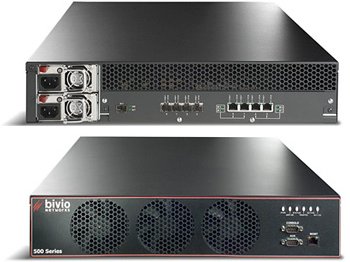Device Profile: Bivio 500 network appliance platform
Nov 22, 2005 — by LinuxDevices Staff — from the LinuxDevices Archive — views Bivio used embedded Linux to build an 8-port programmable network appliance platform targeting emerging and complex network applications requiring Layer 4-7 packet processing at wire speeds. The Bivio 500 features a PowerPC control processor, along with an undisclosed data plane processor. It runs a 2.4-series kernel.
Bivio used embedded Linux to build an 8-port programmable network appliance platform targeting emerging and complex network applications requiring Layer 4-7 packet processing at wire speeds. The Bivio 500 features a PowerPC control processor, along with an undisclosed data plane processor. It runs a 2.4-series kernel.

The Bivio 500 occupies 2U of space in 17-inch racks
Bivio claims the 500 can deliver 2Gbps of application processing, and 4Gbps of network throughput capacity. Potential applications include security, traffic management, XML/SSL/TCP acceleration, load balancing, VoIP, performance monitoring, and IPv6 routing.
Both the applications/control subsystem and the network/data subsystem can be programmed, Bivio says, with an available SDK (software development kit) that provides “straightforward APIs” based on open standards, according to CEO Elan Amir. “Its fully programmable nature at both the packet forwarding and application processing layers [provides unmatched flexibility],” he stated.
Peeking under the hood
Amir declined to provide system specifics, stating, “CPU speed and RAM are not as important as the architecture, which is optimized to deliver multi-gigabit wire-speed performance.”
Amir also provided few details about the Bivio 500's architecture. The Bivio 500 appears to have a PowerPC-based control processor, along with a programmable data plane processor, each with its own independent memory subsystem.
I/O options include gigabit Ethernet, gigabit Ethernet with “hardware bypass,” or 4-port Fiber GE. The device also offers a dual-channel SCSI controller with RAID 1, and redundant power supplies. It is housed in a 2U case for 17-inch racks, and weighs 24 pounds.
Embedded Linux guts
On the software side, the device incorporates a hardened 2.4-series Linux kernel. Amir claims the software environment offers “features not available in other platforms,” such as “configurable mapping of traffic to applications, hardware multicast capabilities to send copies of packets to multiple applications, software-programmable CPU-offloads, hardware-and software-controllable failopen support, and policy-based packet routing.”
Console, telnet, ssh, and web interfaces are available, and the device supports RMON/RMON2, SNMPv2/3, alarm detection and reporting, and software versioning and upgrade support. It is extensible with EJB (enterprise Java beans) and XML capabilities.
Amir says Bivio chose embedded Linux in order to provide its OEM and system integration customers and partners with “unmatched flexibility and manageability, enabling them to easily port their Linux-based network applications.”
This article was originally published on LinuxDevices.com and has been donated to the open source community by QuinStreet Inc. Please visit LinuxToday.com for up-to-date news and articles about Linux and open source.